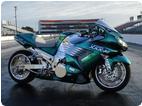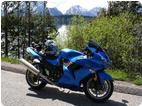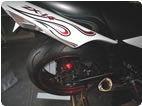Ripped this from PF
http://board.performanceforums.com/forums/showthread.php?s=&threadid=6168
-------------------------------
Octane Boosters
Typed Version of the Article:
Octane boosters are popular in the performance scene because they often
regain power last through detonation. Sold for around $25 in a handy bottle,
they're a convenient fuel additive and horsepower helper. But with so much
brands on the market, you may be fooled into thinking they're all as
effective as each other. Which they're not! Differing chemical compounds,
additives and even volumes, mixed in with a good percentage of advertising,
'independent" testing and testimonials all conspire to confuse the consumer
away from the single most important paint: does it improve the octane
rating?
Let's see what's worth it in octane boosters.
DO I NEED AN OCTANE BOOSTER?
The boys at "The Macquarie Library" describe detonation as: "Excessively
rapid burning of the fuel mixture, often caused by auto-ignition due to
excessive temperatures in the combustion chamber, incorrect ignition timing,
lean mixtures, too high a compression ratio or unsuitable fuel," - as in
too-low an octane rating.
Heard as a faint, metallic rattle, detonation is accompanied by a loss of
power and can cause serious damage to piston crowns.
The significance of detonation is such that many companies produce fuel
additives designed to increase the inherent octane rating of a given fuel.
The proliferation of octane boosters has in part come about in recent times
thanks to low quality Australian fuels. White or "Super" leaded fuel has
been reduced from 98 to 95-96 octane, Premium Unleaded has also dropped to a
minimum of 95 octane. And this presents a problem for high-performance cars
designed to run on higher octane European or 100 octane Japanese fuel.
Japanese import performance cars, Subaru's STI WRX for example, runs an ECU
program for 100 octane, but sometimes detonates on our Australian PULP.
All engines are different though and with Honda's S2000 2.0-litre engine
running a high 11.0:1 compression ratio, it relies on advanced engine
management as much as quality fuel. But it can sustain its power on PULP.
And of course any turbo owner who has experimented with boost will know if
you run too much, it will detonate, so improving the octane is vital for
maximum performance.
We must state that unless an engine is detonation through low RON fuel,
octane boosters have little use. However, in a turbo or high compression
application, the inclusion of a better grade of fuel allows the engine
management system to optimize ignition timing and fueling.
THE CONTESTANTS
For this test we tracked down nine different makes and models of octane
boosters, two fuel "additive," a straight race fuel and a drum of Toluene.
Where there were several different "levels" of octane boosters in the one
brand, we chose the strongest version.
The biggest claims the bottles have is the amount of "points" they claim to
increase. This is ambiguous as a "point" can relate to either 1.0 RON
(Research Octane Number) octane points, or 0.1RON octane points.
The list of entrants in our octane Olympics included:
STP Octane Booster
Wynns Octane 10+ Power Booster,
Amsoil Series 2000 Octane Boost,
Super 104+ Octane Booster,
VP C5 Fuel Additive,
ELF HTX 330 Racing Fuel Stabilizer,
Nulon Pro Strength Octane Booster,
PowerFuel Super Street Nitro Based,
PowerFuel Max Race Nitro Based,
NF Octane Booster Racing Formula,
NOS Octane Booster Racing Formula,
Toluene,
VP Motorsport 103 Unleaded Racing Fuel
THE TEST
To conduct these tests we contracted independent laboratory Intertek Testing
Services, who would test our products on a knock engine.
We had to also find a base fuel to add our boosters to so we went to the
closest public petrol station, a Shell on the outward-bound side of the
Westgate Bridge in Melbourne.
Being a performance-based test, we chose premium unleaded fuel as this
represents the most common high performance fuel (ie: if you start with
regular unleaded, you're wasting money!). We should add that "some" boosters
would have improved the octane rating of regular unleaded proportionately
more than our tests with PULP.
With a RON rating at a minimum of 95, we first established the exact octane
of the PULP. The biggest surprise was our randomly select Shell resulted in
a quite high 96-8 RON.
We precisely measured and mixed each additive to the PULP, according to each
manufacturer's recommendations and specs and poured each into the knock
engine's tank. The compression ratio was then slowly increased until it
started to knock, gaining a threshold of detonation and subsequently a
maximum RON rating.
Of less importance but still worth mentioning is the design of the bottles:
since most people will be pouring it straight into a tank, the design of a
bottle is important to prevent any spillage on paintwork causing damage.
So let's look at the results!
THE RESULTS
BASELINE OCTANE 96.8
Octane points
It's very easy to confuse octane ratings as there are a number of separate
international standards. MON (Motor Octane Number) is the number derived
from a fuel when it's applied to a test engine run at 3000rpm rather than
600rpm and higher inlet temps and ignition advance. The Australian importer
of 104+, Andrew Holdsworth, suggested MON is seen as a more real-world test.
Though none of the fuel companies promote the MON figure which is normally
between 7 and 10 numbers less than RON (Research Octane Number).
Intertek's Graeme Marks believes RON provides the general public with an
idea of which additive works more effectively. And being the most
commonly-used reference, we've used RON for all our tests.
11th
PowerFuel Super Street Nitro Based
946ml treats 35 litres RRP: $35
Right from the start, we were told PowerFuel's additives weren't necessarily
octane boosters, but horsepower helpers. We kept this in mind when testing
both the products, but of the two only the Super Street claimed it was
specifically designed to increase the octane rating of PULP. With a
20-percent nitro mix, Super Street Nitro-Based still improved octane ever so
slightly (0.2RON) but the real test for these two would come on the dyno
runs.
OCTANE IMPROVEMENT: 97.0 (+0.2 RON)
10th
PowerFuel MaxRace Nitro Based
946ml treats 35 litres RRP: $45
Containing another 15 percent more nitromethane than the SuperStreet
formula, MaxRace doesn't claim to increase octane, but the verbal
recommendation was the same, ie: its main characteristic is to boost
horsepower, not octane. For a fair comparison of these two additives, you
need to look at the power they produce. As for octane, it proved very
similar toe the SuperStreet formula bumping up octane ever so slightly.
OCTANE IMPROVEMENT: 97.0 (+0.2 RON)
9th
STP Octane Booster
350ml treats 57 litres RRP: $10.95
One of the cheapest of the group, the STP was also one of the hardest to
find. Auto stores either didn't stock it, or had simply run out! Claiming to
increase the octane 2-5 points, in a well-designed-for-pouring bottle, the
STP - used in the ratio determined by the label - improved the octane
marginally by just over half a point. A little disappointing unless you
interpret STP's claim actually meant 0.2-0.5 points. Then it's a good
result!
OCTANE IMPROVEMENT: 97.4 (+0.6 RON)
8th
Wynns Octane 10+ Power Booster
325ml treats 60 litres RRP: $10
The Wynns was the cheapest of the lot and claimed an increase between two
and five points, again not actually listing what a "point" related to.
Strangely though the 10+ could indicate 1RON and if this is the case going
by our tests it almost lived up to its name. It didn't quite live up to its
claims however, increasing the octane rating by 0.8RON.
OCTANE IMPROVEMENT: 97.6 (+0.8 RON)
7th
Super 104+ Octane Boost
473ml treats 83 litres RRP: $25.95
The acknowledged winner of all previous testing in this country, Super
104+'s bottle stated we should expect an increase between four and seven
point. With a new formula introduced about 12 months ago, identified by an
"Eagle" logo on the back of the bottle, the Super 104+ seems to have lost
its edge with a marginal gain of just less than 1.0RON.
OCTANE IMPROVEMENT: 97.5 (+0.9 RON)
6th
VP Racing C5
355ml treats 75 litres RRP: $19.95
VP has a strong reputation with fuels and its high octane formulas are very
popular (VP?) with drag racers. VP Racing's C5 Fuel Additive lacked any
indication of contents nor claims, but the C5 additive still provided a
reasonable increase of 1.3RON.
OCTANE IMPROVEMENT: 98.1 (+1.3 RON)
5th
NOS Octane Booster Racing Formula
355ml treats 60 litres RRP: $28
NOS, a relatively new octane booster, comes in "1/10th" scale bottles
designed to emulate the actual nitrous bottles of its successful NOS
systems. The Racing Formula is the strongest of three concentrates and
containing Hydrotreated Aliphatics and Methylcyclopentadienyl Manganese
Tricarbonyl (try saying that 10 times in a row), it contains a lead
replacement which NOS claims increases the octane rating by as much as seven
points. Obviously not recommended for street use, it also included with a
handy pouring spout. In testing, it proved a good result improving the
octane rating by almost 2RON.
OCTANE IMPROVEMENT: 98.6 (+1.8 RON) as much as 7 points
4th
ELF 330 Fuel Stabilizer
1000ml treats 50 litres RRP: $45
"If you spill it on your paintwork, don't rub it off - rinse it with water"
were our works of warning. We were also told to "pre-mix" the ELF before
adding it in a fuel tank (which with this test we were doing anyway) as the
ELF has a tendency to settle to the bottom of fuel if it's either not mixed
properly or left to sit. This was made somewhat more difficult by the design
of the bottle, which tends to drip when pouring. With some nasty stuff known
as Aniline, the ELF doesn't claim any numbers, and provided a decent 1.8 RON
point improvement.
OCTANE IMPROVEMENT: 98.6 (+1.8 RON)
3rd
Amsoil Series 2000 Octane Boost
354ml treats 57 litres RRP: $23
Recommended for off-road and racing use, the Amsoil Series 2000 claimed to
increase the octane rating by up to seven points. It came up a little short,
but still proved surprisingly good with a full 2.0RON improvement. And good
enough for the bronze medal in our Octane Booster Olympics.
OCTANE IMPROVEMENT: 98.8 (+2.0 RON)
2nd
Toluene (Toluol)
20 litres treats 100 litres RRP: $48
Since toluene (pronounced toll-you-een - also known as methyl benzine) isn't
a commercially advertised octane booster. We were unsure of exactly what
ratio to mix the clear Toluene to the fuel, with recommendations between 10
and 30 percent. From personal experience, we have seen high percentages
increase octane even further, though 30 percent is considered the maximum.
Available only from various fuel distributors (it is a special order through
services stations), under advice we ran a 20 percent mix (quite a lot more
than the others) and saw an impressive improvement of 2.5 RON, for the
silver medal.
OCTANE IMPROVEMENT: 99.3 (+2.5 RON)
1st
NF Octane Booster Racing Formula
250 ml treats 80 litres RRP: $29.95
Time for an Aussie-made product. From Perth, the NF Octane Booster Racing
Formula was the smallest bottle in the field, but looking at the mixing
ratio, also the strongest NF relies on an incredibly small dose - a mere 3
percent! Claiming to increase octane as much as 6.0 RON, NF took the gold
medal in a surprising tie. If it were a split decision based on
concentration though, it would be the clear winner.
OCTANE IMPROVEMENT: 99.6 (+2.8 RON)
1st
Nulon Pro Strength Octane Booster
500 ml treats 60 litres RRP: $20.95
Note: Also available in four-litre container for $110
The Australian-made Nulon Pro Strength Octane Booster is the top of the
range Nulon fuel product, claiming to boost octane "up to seven number". The
Pro Strength gained a test-winning, gold-medal-gaining and Nf-equalling
2.8RON increase. And at $21, it's good value too!
OCTANE IMPROVEMENT: 99.6 (+2.8 RON)
VP Motorsport 103 fuel
Used straight fuel (20-litre minimum) RRP: $70
Purely for interest, we decided to also test a straight racing fuel. While
there are a number available (such as ELF) for no particular reason we chose
VP. The highest octane VP fuel which was still totally street-legal was the
Motorsport 103. Working out at $3.50 per litre and "designed for maximum
power and throttle response", the VP was very impressive with an octane
rating of 107RON - more than 10RON points more than PULP. Obviously more
expensive than the boosters, if octane is problem, racing fuel like VP may
be the answer.
OCTANE IMPROVEMENT: 107 (+10.2RON)
As the name suggests, a knock engine is designed to test the detonation or
anti-knock rating of fuels and fuel additives. It's a slow revving engine
capable of running most fossil fuels through an adjustable compression
ratio. As the comp ratio increases, it accurately measures the intensity of
the knock and determines the fuel's octane rating.
The world standard is a one-cylinder two-valve four-stroke engine with
exposed valve gear. Archaic in appearance, a carby is fed from any one of
three fuel bowls to allow three different fuels to be run back to back. The
mixture is actually controlled via gravity feed and by raising or lowering
the float level of each bowl!
Run under load via a belt-drive linking the flywheel and load system, it
ensures a real world situation and ensuring minimal variation between tests,
oil temperature, intake air density and air temperature are all monitored
and controlled.
The engine is somewhat agricultural, however its unique ability to vary the
compression ratio while running between 5.0:1 and 15.0:1 is quite amazing.
The operator simply winds a handle and the entire head and cylinder assembly
moves up and down relative to the crankshaft.
A knock sensor measures both the frequency and intensity of the ping (as
displayed on a knock metre). Figures are then cross-referenced on a chart
using the information provided by the knock meter, plus the height of the
head and barrel.
Finally, knock intensity is figured in and the fuel's octane rating
determined.
Taking two hours to warm, this $200,000 engine is super robust and rarely
needs rebuilding. Individual tests can then proceed at approximately $120
per test sample.
Being subjected to so much detonation, you can only imagine how much
maintenance an engine of this nature must need. Interestingly, this isn't
the case as the piston and rod assembly are rejects from a monstrous ship
engine (just kidding)! They're frigging huge with the incredibly thick
piston crown contributing to a combined gudgeon pin and piston weight of
1794 grams! Likewise, the rod weighs an astonishing 1929 grams. The bottom
line is these engines which have replacement value of over $200,000 and
almost never require rebuilding.
DYNO BOOSTERS
Ultimately, the role of an octane booster, is to regain horsepower lost
through detonation or retarded ignition timing due to detonation. But two of
our products, the nitro additives, weren't specifically designed to increase
octane. Instead, they contain a mix of nitromethane (the petrol Top Fuellers
run) in a "percentage" concentrate. Power Fuel's Super Street and Max Race
additives has 20-percent and 35-percent nitro respectively, and the
Australian importer specifically claimed they would increase power, not
necessarily octane.
So, we took those two products, and the two best-performing octane boosters
to MRT Performance for some Dyno Dynamics dyno testing. Interestingly, we
were going to use MRT's rally Civic, which normally runs on avgas. On PULP -
even with the booster - it was pinging too much, so a Jap-spec EF Honda
Civic was used with a 1.6-litre VTEC and about 10.0:1 comp ratio.
The graphs tell the story though, and to be fair to the products, with
variables such as heat soak, the results weren't as conclusive as could be
gained from an engine dyno. But that is not to say the products don't work.
As our test prove, they do, but it's not as easily measured on a chassis
dyno. Plus the Civic had no detonation problems on PULP, further hampering
the "apparent" effectiveness of the boosters.
With changes too small to accurately measure, we would suggest if your
engine is sensitive to octane, a booster is for you. If not, try the nitro
or racing fuels.
CONCLUSION
Both the Nulon Pro Strength and the NF Racing Formula rated the best octane
boosters in our test. And considering that less NF was needed than Nulon, it
evens out a little with a slightly higher cost. Still, both proved extremely
effective at increasing octane, even outranking Toluene, which needs much
higher levels of concentration. The VP Motorsport 103 fuel was an
interesting exercise, and if a little more effort (ie: buying it from the
selected outlets) is worth the octane, it's a good representative of what to
expect from straight racing fuel. As for the nitro additives, if you're not
experiencing any type of detonation, they're definitely worth a try. So
whether you detonate or not, we've found a fuel additive for you!









